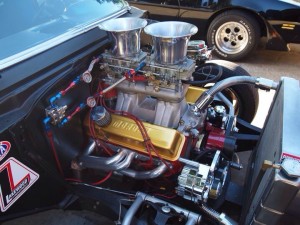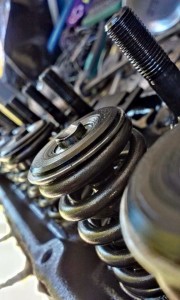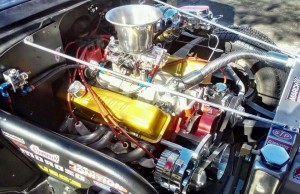
This isn’t your average four door grocery-getter. A 1957 Chevy Bel Air with a tunnel ram and dual quads may seem like a great idea at first, but it quickly becomes a nuisance for casual driving on the street. Its engine, a four bolt main 350 Chevy, was rebuilt in 2007 from the bottom up. The parts list included 11:1 Wiseco pistons, a hefty Erson cam, Summit Racing valves, along with valve springs, pushrods and lifters from Comp Cams. On top of all that sat a Weiand (say why-and) tunnel ram with two Holley 450 CFM carburetors. For all out performance driving and high RPM pulls, this was the perfect setup. The cool factor of this engine was off the charts, but the tunnel ram made cruising around town and daily commutes much more difficult.
On top of all that sat a Weiand (say why-and) tunnel ram with two Holley 450 CFM carburetors. For all out performance driving and high RPM pulls, this was the perfect setup. The cool factor of this engine was off the charts, but the tunnel ram made cruising around town and daily commutes much more difficult.
We decided that it was time for a change; the original plan was only to swap the intake and carburetor setup. After pulling the valve covers off, we realized that this job was about to escalate rather quickly. Even though the engine had all new parts throughout, the block wasn’t a fresh bore. It was bored .030 over but still appeared to be in decent condition so it was only honed. It ran great but it still smoked a bit so some thick Lucas Oil treatment was poured in the motor in an attempt to cut down on the overall oil consumption. At the time, we didn’t think much of it.
When we popped the valve covers off were greeted with an ugly sight: the valve train showed signs of severe wear. A combination of poor oiling and defective rocker arms started eating away at the valve stem tips. At this point in time, we were left with no choice other than to pull the heads for a rebuild. All the valves needed to be replaced along with the springs and rocker arms. It was more than we had originally anticipated on doing, but it was a necessary task.
 We began with pulling both carburetors off, pulling the distributor out and then pulling the intake off. The next step was to disconnect the headers from the down tubes and unbolt them from the heads. The steering shaft that goes from the steering column down to the rack runs through a couple header tubes on the driver side of the engine which made things a little more difficult for us. This meant that the header couldn’t be fully removed without some major disassembly of the steering components. We were able to pull it back just enough to make some room. Cast iron heads aren’t what one would called “lightweight”; lucky for us the entire front end of this Bel Air flips open, making it significantly easier to wrestle them off!
We began with pulling both carburetors off, pulling the distributor out and then pulling the intake off. The next step was to disconnect the headers from the down tubes and unbolt them from the heads. The steering shaft that goes from the steering column down to the rack runs through a couple header tubes on the driver side of the engine which made things a little more difficult for us. This meant that the header couldn’t be fully removed without some major disassembly of the steering components. We were able to pull it back just enough to make some room. Cast iron heads aren’t what one would called “lightweight”; lucky for us the entire front end of this Bel Air flips open, making it significantly easier to wrestle them off!
Once off, the rest of the motor was cleaned and prepped for a fresh coat of paint. Upon further inspection, we noticed that the ProForm electric water pump had sprung a leak and was due for a tear down.
Now that the major components of the engine were disassembled, we began removing the old valves from the heads. The heads were cleaned then masked off for a coat of paint to match the block. New valves and valve seals were ordered through Summit Racing to replace our damaged ones. We installed the valves making sure to use plenty of assembly lube. The new valve stem seals, springs and retainers were then installed to finish things off
After that was completed, a new motor was installed in the water pump housing. It didn’t come with a new gasket, so a new one was made using a sheet of gasket material. Permatex water pump sealant was also used for a little extra insurance. After reinstalling the waterpump on the engine, the deck surfaces were cleaned in preparation for a fresh head gasket and our rebuilt heads. Once the heads were bolted down, new hardened pushrods were installed and topped with a set of stamped steel rocker arms. Our intake and carburetor were still on their way in the mail so we went ahead and assembled as much of the motor as we could. We were eager to install the new intake once it arrived and fire up our Chevy, but it was dark by the time we finished up. The next day we installed the carburetor, dropped the distributor back in and adjusted the valves. From here it was a matter of reinstalling the valve covers and running our plug wires. The carburetor we installed was just being used in order to get the car running again, as a Quick Fuel 680 was to replace it. Once plumbed, the 350 fired right up and sounded healthier than ever.
About a week later we received the Quick Fuel 680 cfm carb and installed it on the engine. We’ve been very impressed with the quality of Quick Fuel carburetors right out of the box, they come with many features that carburetors in the same price range don’t offer. After a final tune, we were ready to hit the road. The new dual plane intake and single 4 barrel carburetor we had chosen greatly improved the quality of driving, gas mileage and throttle response without sacrificing performance. The tunnel ram with dual quads was not the most friendly during a cold start, having given us a hard time during warm up. For street driving, a dual plane intake is ideal. It offers great power throughout the RPM sweep along with better street characteristics.
